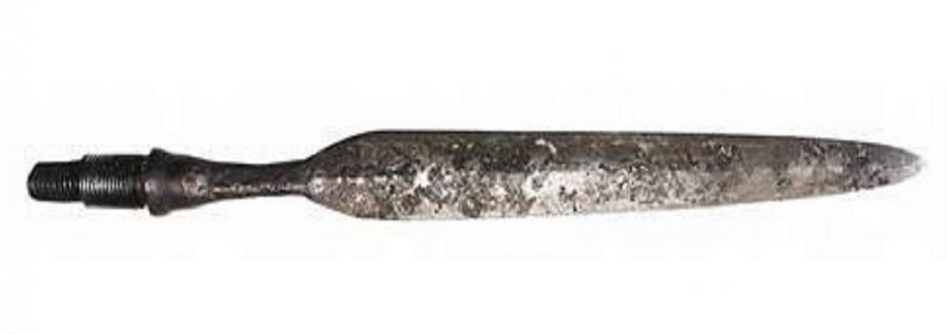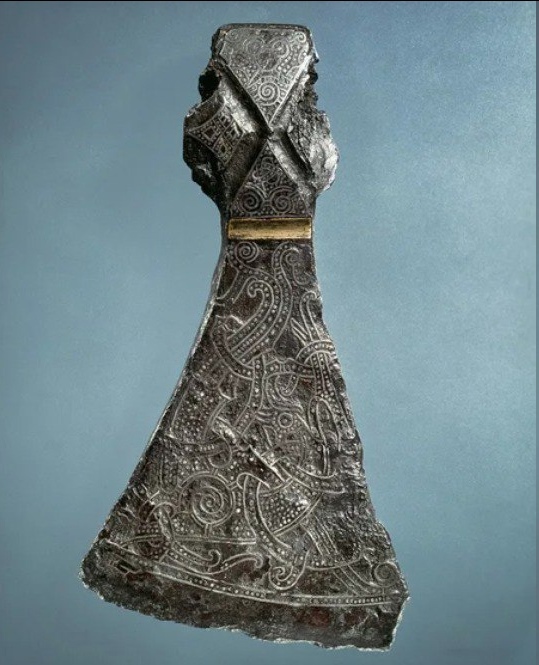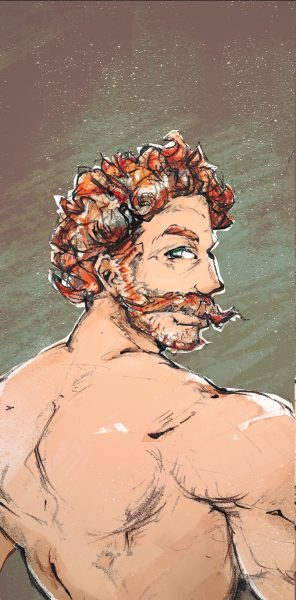And we decided to have a little fun in our free time. A Christian priestly robe from the same period was reconstructed. It was then not much different from ordinary civilian clothing and consisted of an undertunic (tunica linea, made of linen), outer tunic (tunica, usually made of wool) and a lacerne cloak (lacerna). The top two items of clothing were almost always whitened. There were no embroideries, patterns and all sorts of similar things then - they came much later.
Cross
Well, student internship is coming to an end, which means...
...it’s just that we are not saying goodbye to you, because we have industrial practice, and we even get little money for it. We won’t say which ones.
Now let's get down to business. Do you remember that sword that was shown a week ago? Now I have been honored to sketch his guard as well. It is made no less beautifully - shaped like the classic Viking guards of this period, only slightly longer, and also touched with gold. Here you go.
???!!!
Some topical news about what not to do with historical monuments. In no case do I want to stir up anything and, being a Catholic, I treat all religions with respect, but this is just meh.
The proofs are again in Rechansky, so I’ll tell you this: there was a pagan settlement in the Irakli region, it didn’t bother anyone. But then some clever people came and made a mound there (!), built steps (!!) and erected a chapel to Our Lady Esther (!!!). We are enclosing photos for you of how it was and how it turned out.

Φῶςἱλαρὸν
Now - a parchment with the Hellenic Christian hymn Φῶς ἱλαρόν (“Quiet Light”). Now he is terribly popular and known all over the world. The Church claims that the tradition of singing it goes back to the fourth century: you see, it’s true, and maybe even earlier.
I was too lazy to rewrite everything, so I wrote down only three lines:
Φῶς ἱλαρὸν ἁγίας δόξης
ἀθανάτου Πατρός, οὐρανίου,
ἁγίου, μάκαρος, Ἰωσήρ Χριστέ…
“The light of quiet, bright glory
without death, Father heaven,
Holy Blessed, Holy Christ..."
On the reverse side it says: ΑΓΝΟΝ ͵ΓΥΝϚ ΤΗΣ ΕΠΟΧΗΣ ΤΗΣ Γ΄ ΓΛΙΝΝΑΡΙΚΟΝ - “Agnon, [year] 3456 of the Third Age in Glinnar.” This is 337 AD. So much for dating!
PS I sang a couple of musical phrases from there in a modern Hellenic voice.
Ar Dharag Inoittha
We didn't write anything yesterday because...
...went to the ballet.
It seems like a completely idiotic excuse, but it's the absolute truth. The classic Glinnar ballet Ar Dharag Inoittha (Dragar Inoitta) was staged in Hveitstad yesterday Saturday. Coincidence? We also decided that no, so we definitely decided to visit it. How we got the tickets is a completely different story and is not relevant.
To be honest, I don’t understand ballet at all. In the opera everything went well, albeit with a terrible creak, but here it doesn’t work at all. And guess what? It was absolutely amazing! It would seem like complete madness: the riot of colors is such that epileptics can hardly watch it, but despite this, you always clearly understand what is happening and can distinguish all the characters.
The process of Inoitta’s transformation from a dragarian to an alva is very beautifully depicted. Fodallein, although shown to be very straightforward, tough and somewhat cruel, evokes genuine empathy and sometimes even sympathy. Well, she dances divinely, how could she do without it.
The only thing I didn’t like was that it was not indicated anywhere that you need to bring your own handkerchiefs. There are a lot of touching scenes where you can’t do without napkins.
Edge
It’s good that we staked out the excavation site first, and not anyone else. News: a man found the tip of a spear from the 10th-12th centuries (in the attached image), and it turned out to be in such good condition that he attached a handle to it and slaughtered pigs with it.
Proof (in Rechansky)
Evocations of Quijos
And again, before moving on to the main part of the post, let's take a short historical excursion.
==START==
Those of you who have practiced magic professionally may know that at least some unification of the teaching of magical sciences began at the end of the sixteenth century. It was due to the invention of the so-called. automatic enchantments and the subsequent discovery of the phenomenon of magical interference - it is precisely thanks to this abomination that we cannot make several heterogeneous magical processes work locally and simultaneously: they disrupt each other’s work and can lead to completely unexpected results. In short, people SUDDENLY began to understand that magic should have a more serious scientific basis than it had before, and therefore they finally began to listen to other people's opinions.
Before this period, there were a number of large magic schools scattered around the world, and some slightly smaller ones. They all believed that their way of teaching magic was, if not the only correct one, then certainly the best, and somehow they lived like that. On the territory of Orova, the international school/academy of Quijos was especially popular[1]anti-Orean *kʷyóh₁os "peace, quiet, quiet" - even after all major states began to have their own magical universities, enrollment there almost did not decrease.
They had two fundamental principles: firstly, learning should begin as early as possible and as naturally as a child is taught to talk. Modern science fully shares this principle, but they have a lot of complaints about the second: Quijos apologists believed that:
1) language determines thinking
2) the most clearly pure, “virgin” way of thinking is reflected in the most ancient form of language,
therefore, their students (who were recruited mainly from the territory of Orova, of course) were trained to perform all sorts of invocations, evocations and other spells in their reconstruction of the proto-Orowa. The reconstruction was, however, so good that it has hardly lost its relevance even now.
==END==
In general, we found a couple of examples of Quijos evocations all from the same period. We will give them in classical post-Skadin orthography.
Toh diveh prodhehtim-de petkhoitām. Ioh celsiokh khuhntes goltead-qe.
“Let these two fly across the sky to the previously marked land. I will shelter them from the wind and cold.”
Kerps hmei khuhnteh persoit ei krucheh, volcōis, skukhtih hgneghbhi-qe ins svecs trhgscoch.
“My body will be dissolved by the wind if I harm six of them with blood, hair, skin and nails.”
Footnotes
| ↑1 | anti-Orean *kʷyóh₁os "peace, quiet, quiet" |
|---|
Varðveitari
GUYS I WAS ABLE TO TOUCH A REAL SWORD WITH MY HANDS
uh, to the point. We found a two-handed sword from the fourth (!) century, apparently made somewhere in Lavinavia. The find itself is very strange, because the first two-handed swords began to appear at the end of the 12th century AD, and here, well, this. And even in such a form, as if it had been sheathed about five minutes ago - not a trace of rust or anything like that.
I sketched the base of the blade; Then maybe I’ll draw the whole thing. This squirrel with a hammer is etched into the heel itself, and it looks very stubborn. It doesn’t look like Avalanche motifs, it’s something closer to Beta ones, and even then not completely. A little higher is a notch with silver wire, and here the patterns are typically Avalanche (I’m attaching a photo of a real piece of an ax so you can imagine what it looks like in reality).
Well, apparently the name of the sword is engraved on the blade - Varðveitari, from ancient Lavinavian - “Guardian”. Well, Guardian, let's hope you took good care of your master.
Longsword Exchanges
Unriled: I've always been terribly fond of fencing with one and a half hand swords. Watch the vedo and you will understand.
spoiler: REALISTIC
werewolf
And here is our Volkolak - at least, we imagine it to be something like this.









